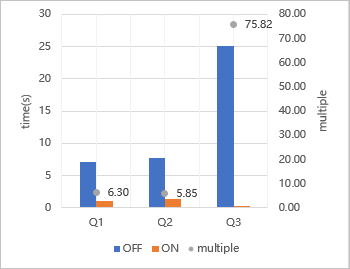When a query that involves a large amount of data is being executed, large amounts of compute resources are consumed as the SQL layer reads data from the storage engine layer and performs computation. To improve query performance, PolarDB for MySQL pushes LIMIT OFFSET down to the storage engine layer. This topic describes the LIMIT OFFSET pushdown feature.
Prerequisites
- 8.0.1.1.16 or later
- 8.0.2.2.0 or later
For more information about how to view the cluster version, see Query the engine version.
Background
In MySQL community, the LIMIT clause is executed at the SQL layer. The SQL layer reads data from the storage engine layer, processes the query, and returns the filtered results based on OFFSET. When secondary indexes are queried and columns in the primary table need to be accessed, the SQL layer must obtain column data from the tables. When no WHERE conditions are processed at the SQL layer, including when predicates are fully pushed down to the storage engine layer, data is filtered based on the LIMIT OFFSET clause without any computation. In this case, large amounts data are transmitted from the storage engine layer to the SQL layer. For a paged query, this causes longer response time as the number of pages increases. PolarDB for MySQL pushes LIMIT OFFSET clauses down to the storage engine, so that the data is filtered at the storage engine layer and not retrieved when secondary indexes are used.
Limits
ON. For more information, see Specify cluster and node parameters.
| Parameter | Level | Description |
|---|---|---|
| ignore_polar_optimizer_rule | Global and session | Species whether to disable the limit for the OFFSET value. Default value: OFF. Valid
values:
|
Use the LIMIT OFFSET pushdown feature
loose_optimizer_switch parameter to enable the LIMIT OFFSET pushdown feature For more information, see Specify cluster and node parameters.
| Parameter | Level | Description |
|---|---|---|
| loose_optimizer_switch | Global and session | Specifies whether to enable the query optimization features of PolarDB. Variables
related to the LIMIT OFFSET pushdown feature:
|
Performance test
Using limit-offset pushdown is returned for the Extra parameter.
- Common LIMIT OFFSET scenarioIn the following example, Q1 of the TPC-H test is used. The primary table is accessed and the statement contains not predicate conditions.
EXPLAIN SELECT * FROM lineitem LIMIT 10000000, 10\G *************************** 1. row *************************** id: 1 select_type: SIMPLE table: lineitem partitions: NULL type: ALL possible_keys: NULL key: NULL key_len: NULL ref: NULL rows: 59440464 filtered: 100.00 Extra: Using limit-offset pushdown - LIMIT OFFSET scenario with predicate conditionsFor queries that contain predicate conditions, if the predicate conditions cover the range based on which the storage engine scans data, the predicate conditions are deleted by the full predicate pushdown feature. In this case, LIMIT OFFSET clauses can be pushed down.
- The execution plan of Q2 accesses the primary key and contains range conditions based
on the primary key.
EXPLAIN SELECT * FROM lineitem WHERE l_orderkey > 10 AND l_orderkey < 60000000 LIMIT 10000000, 10\G *************************** 1. row *************************** id: 1 select_type: SIMPLE table: lineitem partitions: NULL type: range possible_keys: PRIMARY,i_l_orderkey,i_l_orderkey_quantity key: PRIMARY key_len: 4 ref: NULL rows: 29720232 filtered: 100.00 Extra: Using limit-offset pushdown - The execution plan of Q3 accesses the secondary index, contains range conditions based
on the primary key, and must obtain data of other columns from the tables.
EXPLAIN SELECT * FROM lineitem WHERE l_partkey > 10 AND l_partkey < 200000 LIMIT 5000000, 10\G *************************** 1. row *************************** id: 1 select_type: SIMPLE table: lineitem partitions: NULL type: range possible_keys: i_l_partkey,i_l_suppkey_partkey key: i_l_suppkey_partkey key_len: 5 ref: NULL rows: 11123302 filtered: 100.00 Extra: Using limit-offset pushdown
- The execution plan of Q2 accesses the primary key and contains range conditions based
on the primary key.
- LIMIT OFFSET scenario with ORDER BY clauses and ordering indexesIn a standard paged query, ORDER BY is used to sort the query results. When indexes are used to accelerate the ORDER BY clause, the LIMIT OFFSET clause can be pushed down after the predicates are deleted at the SQL layer.
EXPLAIN SELECT * FROM lineitem WHERE l_partkey > 10 AND l_partkey < 200000 ORDER BY l_partkey LIMIT 5000000, 10\G *************************** 1. row *************************** id: 1 select_type: SIMPLE table: lineitem partitions: NULL type: range possible_keys: i_l_partkey,i_l_suppkey_partkey key: i_l_suppkey_partkey key_len: 5 ref: NULL rows: 11123302 filtered: 100.00 Extra: Using limit-offset pushdown
Performance improvements
